You can slash your heating bills with affordable alternatives to traditional systems. Solar air collectors harness sunlight for warmth, while passive solar design uses strategic window placement and thermal mass. Trombe walls capture and store solar energy, releasing heat at night. Solar thermal systems heat both your home and water efficiently. For a budget-friendly option, try DIY solar air heaters. Solar chimneys and attic fans improve ventilation, reducing cooling costs. Solar-powered heat pumps offer year-round comfort, and solar radiant floor heating provides consistent warmth. These eco-friendly solutions not only save money but also reduce your carbon footprint. Exploring these options could transform your home's energy profile.
Solar Air Collectors
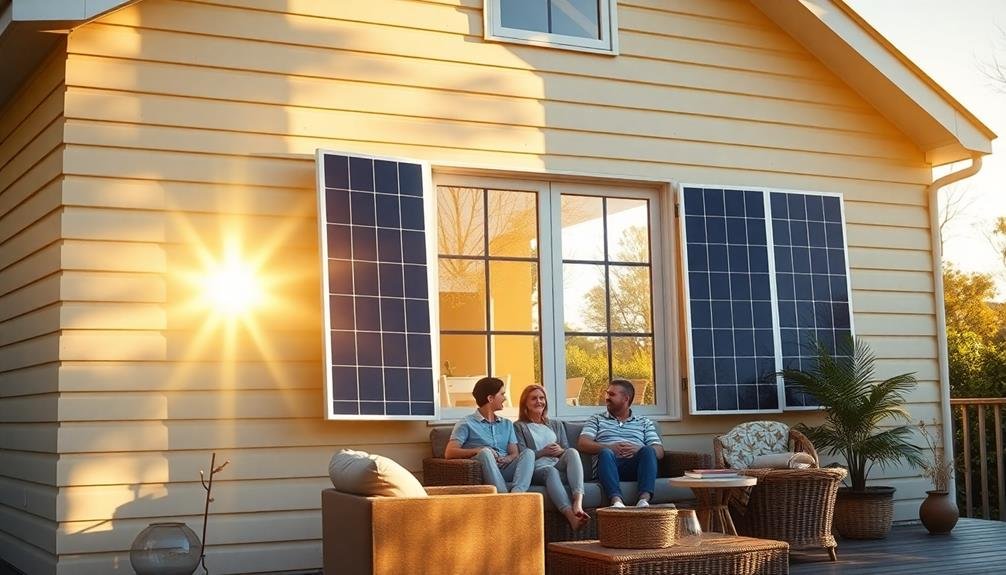
Solar air collectors offer an innovative way to harness the sun's energy for home heating. These systems consist of a dark-colored absorber plate, enclosed in a glass-covered box, which heats up when exposed to sunlight. As air passes through the collector, it's warmed and then circulated into your home using fans or natural convection.
You'll find two main types of solar air collectors: wall-mounted and roof-mounted. Wall-mounted collectors are typically less expensive and easier to install, making them ideal for DIY enthusiasts. Roof-mounted collectors, while more complex, can be more efficient due to their ideal sun exposure.
One of the biggest advantages of solar air collectors is their low operating cost. Once installed, they require minimal maintenance and use no fuel other than sunlight. They're particularly effective in cold, sunny climates and can greatly reduce your reliance on traditional heating methods.
However, solar air collectors do have limitations. They only work during daylight hours and may not provide sufficient heat on cloudy days or at night. To maximize their effectiveness, you'll need to combine them with other heating methods or thermal storage systems.
Passive Solar Design
Simplicity lies at the heart of passive solar design, a method that harnesses the sun's energy without complex mechanical systems. You'll find this approach relies on strategic placement of windows, thermal mass, and insulation to naturally heat your home during colder months.
To implement passive solar design, you'll want to orient your home's longest side and largest windows southward. This maximizes sun exposure during winter when the sun's path is lower. You can install overhangs or awnings to block the higher summer sun, preventing overheating.
Inside, you'll need thermal mass materials like concrete floors or stone walls to absorb and store heat during the day, releasing it at night. Insulation is essential to retain this captured warmth. You'll want to focus on sealing air leaks and insulating walls, floors, and roofs effectively.
Passive solar design can greatly reduce your heating costs, but it's most effective when incorporated during initial construction. However, you can still apply some principles to existing homes through strategic renovations and landscaping.
Trombe Walls
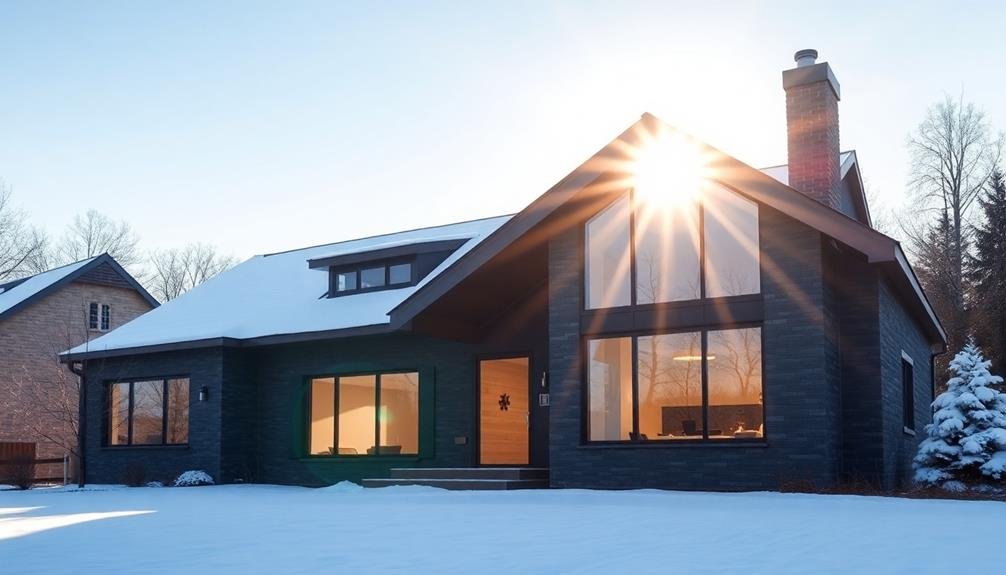
You'll find Trombe walls to be an innovative passive solar heating solution for your home.
These specialized walls absorb sunlight during the day and release heat into your living space at night, potentially reducing your energy bills considerably.
While installation requires careful planning and professional expertise, the long-term benefits of Trombe walls include improved thermal comfort and minimal maintenance needs.
How Trombe Walls Work
Numerous homeowners are turning to Trombe walls as an innovative passive solar heating solution.
These walls work by capturing and storing solar energy, then slowly releasing it into your home. A Trombe wall consists of a thick, dark-colored wall facing south, with a glass layer installed a few inches in front of it. The space between the wall and glass creates a greenhouse effect, trapping heat.
Here's how a Trombe wall functions:
- Sunlight passes through the glass and heats the dark wall surface
- The wall absorbs and stores thermal energy throughout the day
- Heat slowly transfers through the wall, warming your interior space
- Vents at the top and bottom of the wall allow for air circulation
- The system can be reversed in summer to aid in cooling
You'll find that Trombe walls are most effective in climates with cold, sunny winters and moderate summers.
They're low-maintenance and can considerably reduce your heating costs. However, they require careful design and proper orientation to maximize efficiency.
When implemented correctly, Trombe walls can provide a sustainable, cost-effective heating solution for your home.
Benefits of Trombe Walls
Boasting an array of advantages, Trombe walls offer homeowners a compelling passive solar heating solution. You'll appreciate their ability to reduce energy costs by harnessing the sun's power to heat your home. These walls can provide up to 30% of your heating needs, considerably lowering your reliance on traditional heating systems.
Trombe walls excel at maintaining a consistent indoor temperature, creating a more comfortable living environment. They work silently and require minimal maintenance, ensuring long-term savings and hassle-free operation. You'll also benefit from improved indoor air quality, as Trombe walls don't circulate dust or allergens like forced-air systems.
These walls contribute to your home's sustainability efforts, reducing your carbon footprint by decreasing fossil fuel consumption. They're particularly effective in climates with cold winters and abundant sunlight. You can integrate Trombe walls into both new construction and existing homes, making them a versatile option for various property types.
Additionally, Trombe walls can enhance your home's aesthetic appeal, serving as an attractive architectural feature. They offer sound insulation properties, helping to create a quieter indoor environment.
With proper design, you can even use Trombe walls for cooling in summer months, further increasing their year-round utility.
Installation and Maintenance
While Trombe walls offer numerous benefits, proper installation and maintenance are essential to maximizing their effectiveness. You'll need to carefully plan the wall's placement, guaranteeing it faces south in the Northern Hemisphere to capture maximum sunlight. The wall's thickness and material selection are important for ideal heat absorption and distribution.
When installing a Trombe wall, consider these fundamental factors:
- Proper insulation to prevent heat loss
- Adequate ventilation to control temperature and humidity
- Appropriate glazing material for ideal solar gain
- Correct sizing of vents for efficient air circulation
- Integration with existing heating systems
Regular maintenance is critical for your Trombe wall's longevity and performance. You should clean the glazing periodically to maintain solar transmission efficiency.
Inspect the wall for cracks or damage, addressing any issues promptly to prevent heat loss. Check vents and dampers to confirm they're functioning correctly, and lubricate moving parts as needed.
You'll also want to monitor the wall's performance throughout the year, adjusting vents and coverings seasonally to enhance heating and cooling.
Solar Thermal Systems
Solar thermal systems offer an eco-friendly and cost-effective way to heat your home. These systems harness the sun's energy to warm your living space and water, reducing your reliance on traditional heating methods. They work by collecting solar radiation through roof-mounted panels filled with a heat-transfer fluid, which then circulates to heat your home's water or air.
You'll find two main types of solar thermal systems: active and passive. Active systems use pumps and controls to circulate the heated fluid, while passive systems rely on natural convection. For home heating, you'll typically use an active system with either liquid or air as the heat-transfer medium.
To maximize efficiency, you'll need to position your solar collectors facing south and at an ideal angle. While the initial investment can be substantial, you'll recoup costs through reduced energy bills over time. Many regions offer incentives and tax credits to offset installation expenses.
Solar thermal systems require minimal maintenance, typically just an annual inspection and occasional fluid replacement. They're particularly effective in sunny climates but can still provide significant benefits in areas with less direct sunlight.
DIY Solar Air Heaters
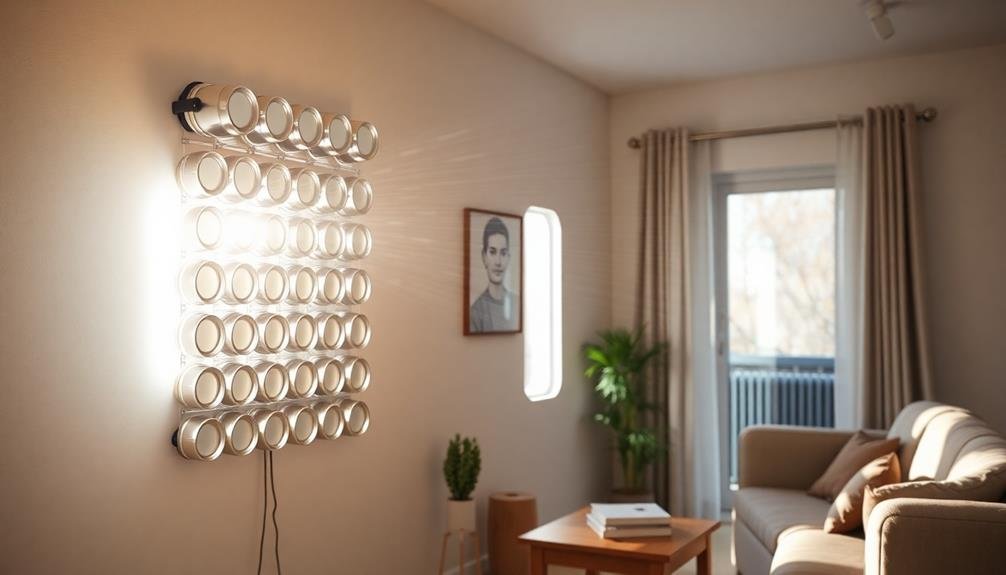
For budget-conscious homeowners, DIY solar air heaters offer an affordable and accessible alternative to commercial solar thermal systems. These simple devices use the sun's energy to heat air, which is then circulated into your home.
You can build a basic solar air heater using readily available materials like wood, plexiglass, and black paint.
To create your own solar air heater, you'll need to:
- Choose a south-facing wall or roof for installation
- Construct a wooden frame to house the heater
- Paint the interior black to absorb maximum heat
- Install a clear cover (plexiglass or polycarbonate)
- Add intake and outlet vents for air circulation
The effectiveness of your DIY solar air heater depends on factors like size, location, and local climate. While it won't replace your primary heating system, it can supplement your home's warmth and reduce energy costs.
You'll find numerous online tutorials and plans to guide you through the construction process. Remember to take into account local building codes and regulations before installing your solar air heater.
With some basic carpentry skills and a weekend of work, you can harness the sun's power to heat your home affordably.
Sunspace Additions
Another way to harness the sun's energy for home heating is through sunspace additions. These are enclosed spaces attached to your home's south-facing wall, designed to capture and store solar heat. You'll find they're fundamentally greenhouse-like structures that can greatly reduce your heating costs.
Sunspaces work by allowing sunlight to enter through large, south-facing windows. The heat is then absorbed by thermal mass materials like concrete floors, brick walls, or water containers. As the day progresses, this stored heat is slowly released into your home.
To maximize efficiency, you'll want to guarantee proper insulation and ventilation. Install energy-efficient windows and consider using movable insulation for nighttime heat retention. You can also add fans to distribute warm air throughout your house.
While sunspaces require an initial investment, they offer long-term savings on heating bills. They're particularly effective in climates with cold winters and abundant sunshine.
As an added bonus, you'll gain extra living space that can be used for growing plants or as a relaxing sunroom. Remember, proper design and integration with your existing heating system are vital for peak performance.
Solar Water Heating
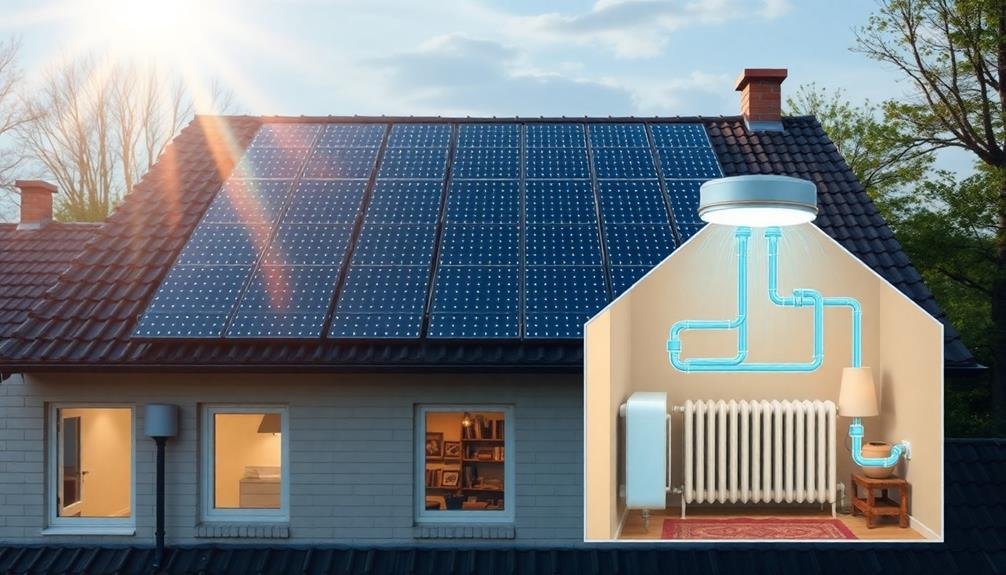
One of the most effective ways to reduce your energy bills is through solar water heating. This system uses the sun's energy to heat water for your household needs, markedly cutting down on your reliance on traditional energy sources.
Solar water heaters can be integrated into your existing plumbing system, making them a versatile option for both new and older homes.
You'll find several benefits to implementing solar water heating:
- Lower energy costs, with savings of up to 80% on water heating bills
- Reduced carbon footprint and environmental impact
- Increased home value and potential tax incentives
- Low maintenance requirements and long lifespan
- Ability to work in various climates, even with limited sunlight
To get started, you'll need to choose between active and passive solar water heating systems. Active systems use pumps to circulate water, while passive systems rely on natural convection.
Your choice will depend on your climate, budget, and specific needs. Installation costs can vary, but the long-term savings often outweigh the initial investment.
With proper sizing and installation, you'll enjoy hot water year-round while markedly reducing your energy consumption and costs.
Solar Roof Tiles
Solar roof tiles offer an innovative way to harness the sun's energy for your home heating needs.
You'll find these tiles can efficiently produce electricity while seamlessly integrating with your roof's aesthetics.
However, you should consider both the potential energy savings and the higher upfront costs for installation and maintenance when deciding if solar roof tiles are right for your home.
Efficiency and Energy Production
Harnessing the power of the sun, photovoltaic roof tiles offer an innovative solution for homeowners seeking to reduce their heating costs while boosting energy efficiency.
These solar tiles seamlessly integrate into your existing roof, converting sunlight into electricity to power your home's heating systems.
The efficiency and energy production of solar roof tiles depend on various factors:
- Geographical location and sun exposure
- Roof angle and orientation
- Tile quality and technology
- Local climate conditions
- Proper installation and maintenance
You'll find that solar tiles can generate significant amounts of electricity, potentially covering a large portion of your home's energy needs.
On average, a solar tile system can produce between 40 to 70 watts per square foot, depending on the factors mentioned above.
Installation and Maintenance Costs
While the long-term benefits of solar roof tiles are substantial, you should be prepared for significant upfront costs. Installation expenses can range from $15,000 to $50,000, depending on your roof size and the system's capacity. You'll need to factor in the cost of the tiles, inverters, and professional installation.
Maintenance costs for solar roof tiles are relatively low, but you'll still need to budget for occasional cleaning and inspections. Here's a breakdown of potential costs:
| Item | Initial Cost | Annual Maintenance |
|---|---|---|
| Solar Roof Tiles | $10,000 – $40,000 | $100 – $200 |
| Inverter | $1,000 – $2,500 | $0 – $100 |
| Installation Labor | $3,000 – $7,500 | N/A |
| Inspections | N/A | $150 – $300 |
Keep in mind that these costs can vary based on your location, roof complexity, and chosen brand. You may also need to replace the inverter after 10-15 years, which can cost $1,000 to $2,500. Despite the initial investment, you'll likely recoup the costs through energy savings and increased home value over time.
Solar Window Films

Window films offer an innovative approach to improving your home's energy efficiency. These thin, adhesive sheets can be applied to your existing windows, providing numerous benefits for heating and cooling. Solar window films work by reflecting solar radiation, reducing heat gain in summer and heat loss in winter.
You'll find several advantages to using solar window films:
- Lower energy bills
- Improved comfort by reducing hot and cold spots
- UV protection for furniture and flooring
- Enhanced privacy without sacrificing natural light
- Quick and easy installation compared to window replacement
When choosing solar window films, consider the climate in your area. In colder regions, opt for low-e films that retain indoor heat. For warmer climates, select films with higher solar heat rejection properties.
You can install these films yourself, but professional installation guarantees peak performance and longevity.
While the initial cost of solar window films may seem high, they're a cost-effective alternative to replacing windows. You'll typically see a return on investment within 3-5 years through energy savings.
Additionally, some utility companies offer rebates for energy-efficient upgrades, potentially offsetting the cost further.
Solar Chimneys
Solar chimneys offer a unique approach to natural ventilation and heating in homes. These passive solar systems use the sun's energy to create a natural convection current, drawing cool air from the lower levels of your house and expelling warm air through the top.
To install a solar chimney, you'll need to create a tall, narrow structure on your roof with a dark-colored, heat-absorbing material inside. As sunlight heats the air within the chimney, it rises and escapes through vents at the top. This creates a vacuum effect, pulling cooler air from your home's lower levels.
In winter, you can use solar chimneys to circulate warm air throughout your house. By positioning vents strategically, you'll draw heated air from sunny rooms to cooler areas.
During summer, they'll help cool your home by venting hot air and creating a natural airflow.
While initial installation costs can be significant, solar chimneys can reduce your reliance on traditional heating and cooling systems, potentially lowering your energy bills.
They're especially effective in climates with distinct temperature differences between day and night.
Solar Attic Fans
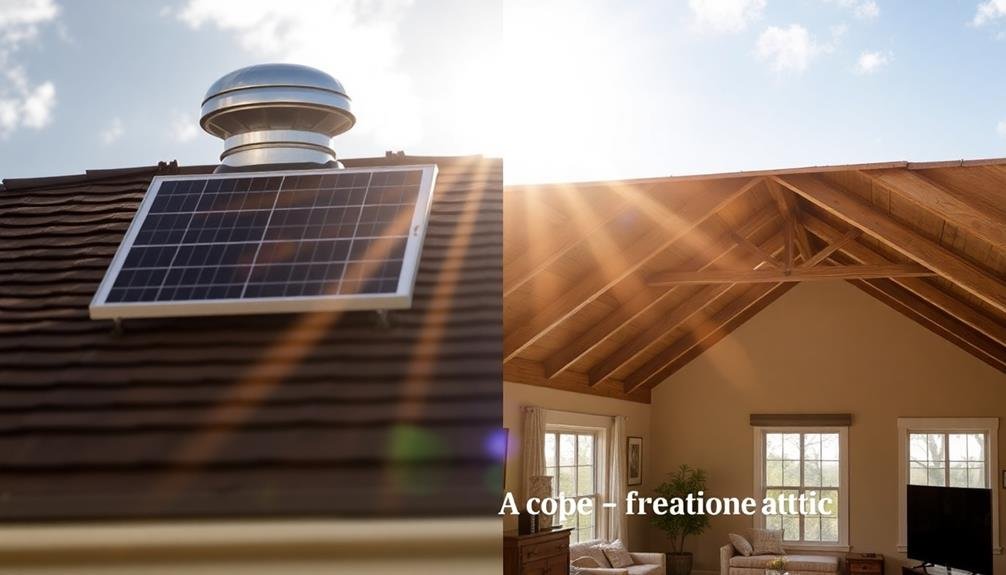
Harnessing the sun's power, solar attic fans offer an energy-efficient solution for regulating your home's temperature.
These devices work by expelling hot air from your attic, reducing the overall heat in your home and easing the burden on your cooling system. You'll find that solar attic fans can notably lower your energy bills while improving your home's comfort.
Installing a solar attic fan is relatively straightforward, and you won't need to worry about complex wiring or electrical work.
The fan operates independently, using solar energy to power its motor. This means you'll enjoy the benefits without increasing your electricity consumption.
Here are some key advantages of solar attic fans:
- Reduce cooling costs by up to 30%
- Extend the life of your roof by preventing moisture buildup
- Improve indoor air quality by reducing mold and mildew growth
- Operate silently, causing no disturbance to your home life
- Require minimal maintenance, with no ongoing operational costs
While solar attic fans are primarily designed for cooling, they can indirectly contribute to more efficient heating during winter months by reducing moisture and maintaining a consistent attic temperature.
This helps prevent ice dams and protects your roof's integrity.
Solar-Powered Heat Pumps
Solar-powered heat pumps offer an innovative solution for home heating, even in cold climates.
You'll find that installation and maintenance costs can be offset by long-term energy savings and increased home value.
Check your local area for government incentives, which can greatly reduce your initial investment in this eco-friendly heating option.
Efficiency in Cold Climates
Powering heat pumps with solar energy might seem counterintuitive in cold climates, but it's actually an efficient and cost-effective solution. Modern heat pumps can operate effectively even in sub-zero temperatures, and when paired with solar panels, they can greatly reduce your heating costs.
In cold climates, solar-powered heat pumps offer several advantages:
- Reduced reliance on the grid during peak winter demand
- Lower carbon footprint compared to fossil fuel heating systems
- Ability to store excess solar energy for use during nighttime or cloudy days
- Potential for net-zero energy consumption in well-insulated homes
- Year-round benefits, as the system can also provide cooling in summer
To maximize efficiency, you'll need to properly size your solar array and heat pump system. Consider factors like your home's insulation, local climate, and energy consumption patterns.
You may also want to invest in a backup heating source for extremely cold days or extended periods of low sunlight. While the initial investment can be higher than traditional heating systems, the long-term savings and environmental benefits make solar-powered heat pumps an attractive option for homeowners in cold climates.
Installation and Maintenance Costs
Three key factors influence the installation and maintenance costs of solar-powered heat pump systems: equipment expenses, labor costs, and ongoing maintenance requirements.
Equipment costs vary based on system size and quality, with prices ranging from $15,000 to $35,000 for a complete setup. Labor costs depend on your location and the complexity of the installation, typically adding $3,000 to $8,000 to the total.
You'll need to budget for regular maintenance, including annual inspections and filter replacements. These costs are generally low, averaging $100 to $200 per year. However, you may face occasional repairs or component replacements over the system's lifetime.
While the initial investment is substantial, you'll benefit from significant energy savings and potential tax incentives. Many regions offer rebates or tax credits for installing solar-powered heat pumps, which can offset a portion of your costs.
Additionally, your energy bills will decrease dramatically, with savings of 50% to 80% compared to traditional heating systems.
To maximize your investment, guarantee proper sizing and professional installation. This will optimize efficiency and minimize future maintenance issues, helping you reap the long-term benefits of your solar-powered heat pump system.
Government Incentives Available
Numerous government incentives are available to homeowners who install solar-powered heat pump systems. These incentives can greatly reduce your upfront costs and accelerate your return on investment.
The federal government offers a 30% tax credit on the total cost of installation, including equipment and labor. Many states and local municipalities provide additional rebates, grants, or low-interest loans to further offset expenses.
To take advantage of these incentives, you'll need to:
- Research available programs in your area
- Verify your system meets specific efficiency requirements
- Work with a certified installer
- Keep detailed records of all expenses
- File the appropriate paperwork with your tax returns
It's important to note that incentives may change over time, so it's best to act quickly when you find a program that suits your needs.
Some utility companies also offer special rates or net metering for solar-powered systems, allowing you to sell excess energy back to the grid. By combining these various incentives, you can make solar-powered heat pumps a more affordable and attractive option for your home heating needs.
Solar Radiant Floor Heating
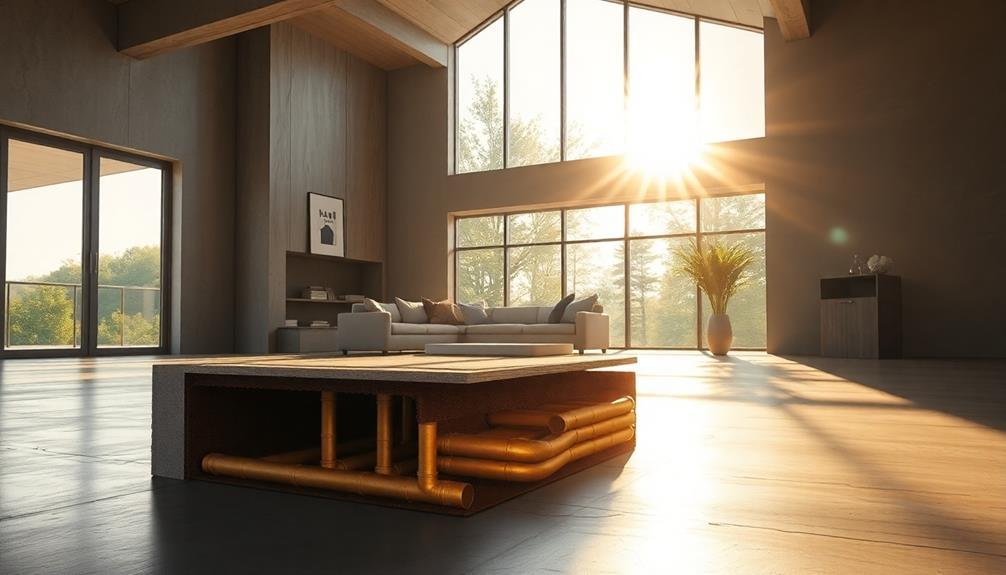
Have you ever dreamed of a warm floor beneath your feet on a chilly morning? Solar radiant floor heating can make this a reality while offering an eco-friendly and cost-effective heating solution for your home. This system uses solar panels to collect energy from the sun, which is then used to heat water or an antifreeze solution that circulates through pipes installed underneath your flooring.
You'll find that solar radiant floor heating provides consistent warmth throughout your home, eliminating cold spots and drafts. It's also highly efficient, as the heat rises evenly from the floor, warming objects and people directly rather than just the air. This can lead to significant energy savings over time.
While the initial installation costs may be higher than traditional heating systems, you'll benefit from lower operating costs and reduced reliance on fossil fuels.
Additionally, solar radiant floor heating is compatible with various flooring materials, including tile, hardwood, and even carpeting. It's a silent, invisible heating option that won't interfere with your home's aesthetics or furniture placement, making it an attractive choice for homeowners seeking both comfort and efficiency.
Frequently Asked Questions
How Do Government Incentives Affect the Cost of Solar Heating Installations?
You'll find that government incentives greatly reduce solar heating installation costs. They offer tax credits, rebates, and grants that can cover up to 30% of your expenses. These programs make solar heating much more affordable for homeowners.
What Maintenance Is Required for Solar Heating Systems in the Long Term?
You'll need to regularly clean solar panels, inspect for damage, and replace components like pumps or fluids every 10-15 years. It's also important to check system performance annually and clear any debris from collectors.
Can Solar Heating Be Effectively Combined With Traditional Heating Methods?
Yes, you can effectively combine solar heating with traditional methods. You'll use solar energy when available, reducing your reliance on conventional systems. This hybrid approach maximizes efficiency and guarantees you're always comfortable, regardless of weather conditions.
How Do Solar Heating Solutions Perform in Areas With Limited Sunlight?
In areas with limited sunlight, solar heating solutions aren't as effective. You'll see reduced performance and may need to rely more on backup systems. It's important to take into account your location's climate when choosing solar heating options.
What's the Average Payback Period for Investing in Solar Heating Alternatives?
You'll typically see a payback period of 5-10 years for solar heating investments. However, it's not one-size-fits-all. Your specific timeframe depends on factors like local energy costs, available incentives, and your system's efficiency.
In Summary
You've got plenty of affordable solar heating options to explore. From passive designs to DIY air heaters, there's a solution for every budget and skill level. Don't forget to take into account solar-powered heat pumps and radiant floor heating for more all-encompassing systems. By harnessing the sun's energy, you'll not only save money but also reduce your carbon footprint. Take the time to research and implement these alternatives—your wallet and the planet will thank you.
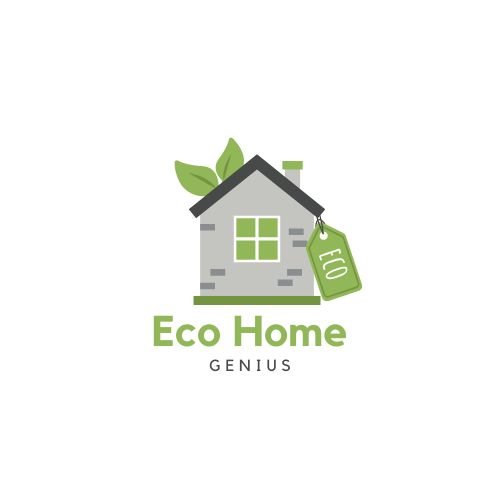
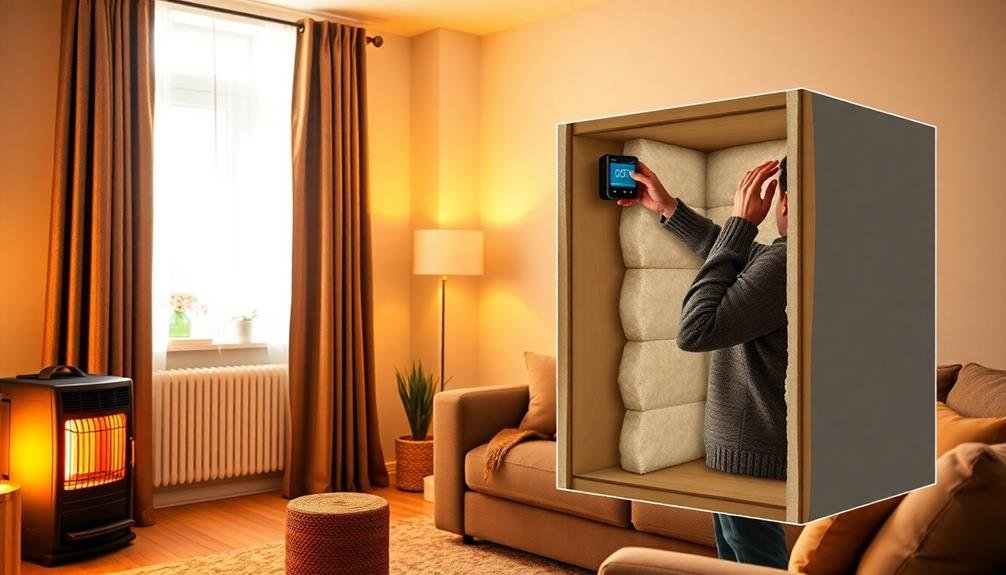
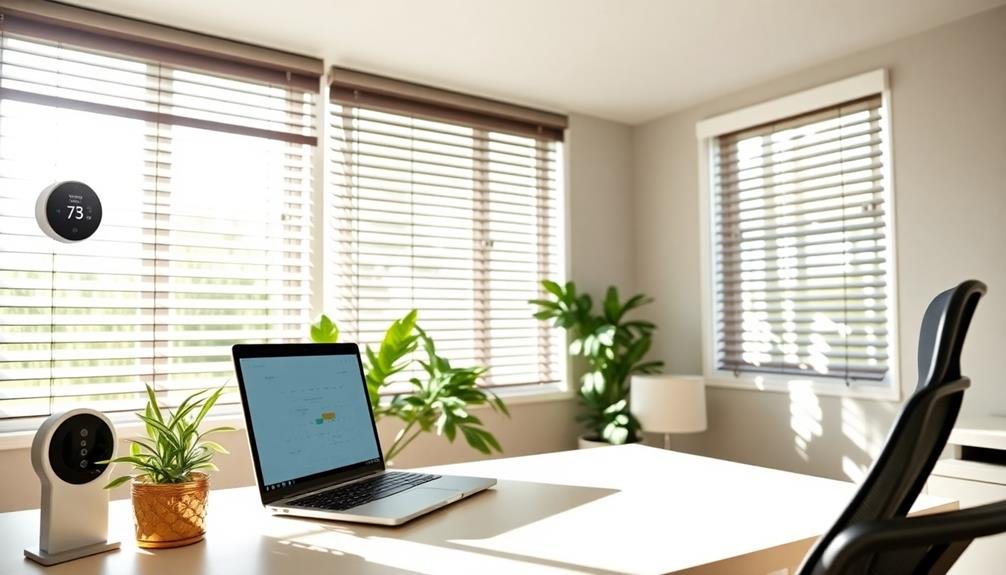
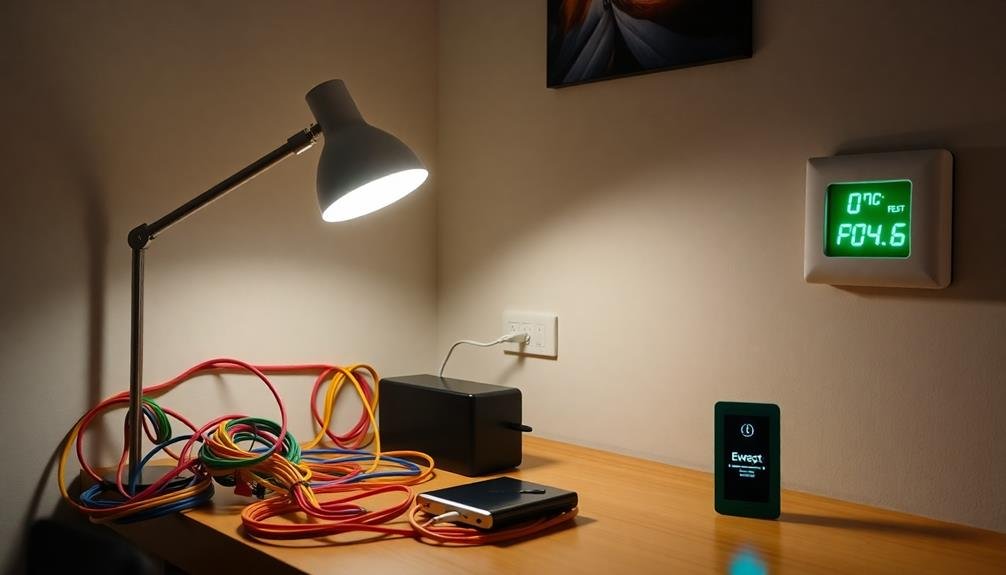
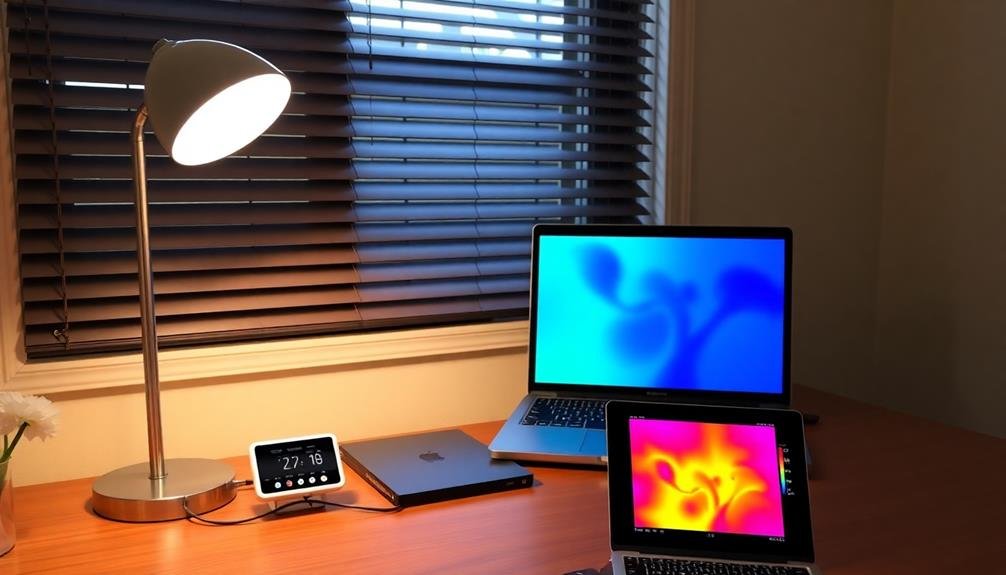
Leave a Reply